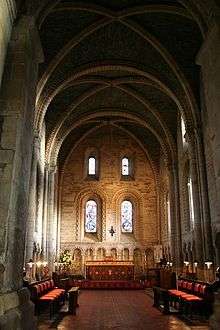Stow Minster
The Minster Church of St Mary, Stow in Lindsey, is a major Anglo-Saxon church in Lincolnshire and is one of the largest and oldest parish church buildings in England. It has been claimed that the Minster originally served as the cathedral church of the diocese of Lindsey, founded in the 7th century and is sometimes referred to as the "Mother Church of Lincolnshire".[1]

It is partly Saxon and partly Norman in date and is designated by English Heritage as a Grade I listed building[2] and was also included in the World Monuments Fund's 2006 list of the world's 100 most endangered sites.[3] It has the tallest Saxon arches of its time in Britain,[4] the earliest known example of Viking graffiti in England (a rough scratching of an oared Viking sailing ship, probably dating from the 10th century), an Early English font standing on nine supports with pagan symbols around its base and an early wall painting dedicated to St Thomas Becket.
History

The bishop's seat at Sidnacester (Syddensis) has been placed, by various commentators, at Caistor, Louth, Horncastle and, most often, at Stow, all in present-day Lincolnshire, England,[5] but the location remains unknown.[6] More recently Lincoln has been suggested as a possible site.[5]
There had been a church in Stow even before the arrival of the Danes in 870, the year they are documented to have burnt the church down.[7][1] The building remained in ruins until an abbey was built in 1040, reputedly by bishop Eadnoth II.[1]
Ralph de Diceto attributes the church's foundation to Elnothus Lincolniensis, almost certainly Aelfnoth, Bishop of Dorchester, c. 975, who built the church, possibly on the site of an earlier wooden Saxon church, to serve as a minster (or mother church) for the Lincolnshire part of his large diocese. It was a second cathedral because part of the bishop's household of priests (which later became the cathedral chapter) lived in Stow and administered this part of the diocese. The memory of this period gave rise to the tradition that Stow is the Mother Church of Lincoln Cathedral.
It is said to have been re-founded and re-endowed in 1054 by Leofric and Godiva encouraged by Wulfwig as a minster of secular canons with the bishop at its head. In 1091 Remigius of Fécamp re-founded it as an abbey and brought monks to it from Eynsham Abbey, describing the church as having been a long time deserted and ruined. Within five years his successor had transferred the monks back whence they had come and St Mary's had become a parish church.
In 1865 J. L. Pearson built the stair turret outside the church. This was originally inside the church in the nave up against the north side of the tower arch. At the same time some windows were altered and the church was re-roofed. A new vestry was added in the early 1990s (some skeletons and a broken 13th-century limestone cross were found during the work).
A mile to the west of the village and lying just to the south of the Roman road from Lincoln to York, known as Tillbridge Lane, are the remains of the medieval palace of the bishops of Lincoln built in 1336. All that can be seen today are the earthworks of the moat and to the north and east of the site the earthwork remains of its associated medieval fish-ponds.
Conservation issues
The church is a Grade I listed building,[2] and is included in the 100 most endangered sites in the world by the World Monuments Fund in 2006. The site is also a Scheduled Ancient Monument, though the building itself is excluded from the schedule.[8]
The first stage of conservation needed is weatherproofing.[9] Only then can internal decoration can be addressed.[9] It is estimated that the work will take at least 10 years to complete and cost between £2 million and £3 million at current prices.[9]
References
- "Stow-in-Lindsey". GENUKI. Retrieved 15 June 2007.
- Historic England. "Church of St Mary (Grade I) (1146624)". National Heritage List for England. Retrieved 14 November 2017.
- "Parish church on world risk list". BBC News. Retrieved 9 April 2008.
- "Venue details". Lincolnshire County Council. Retrieved 9 April 2008.
- Jeffery, Paul (31 March 2012). England's Other Cathedrals. History Press Limited. p. 45. ISBN 978-0-7524-9035-9.
- Lapidge, Michael; Blair, John; Keynes, Simon; Scragg, Donald (2 October 2013). The Wiley Blackwell Encyclopedia of Anglo-Saxon England. John Wiley & Sons. p. 294. ISBN 978-1-118-31609-2.
- Criddle, Peter (October 2008). "Lincolnshire and the Danes" (PDF). Lincolnshire Life. County Life Ltd: 16. Retrieved 10 April 2012.
At Stow, Lincolnshire's mother-church before the building of Lincoln's Cathedral, the bishop was murdered and the church burnt down.
- Historic England. "Site of a college and Benedictine Abbey, St Mary's Church (1012976)". National Heritage List for England. Retrieved 29 May 2018.
- "Projects". Stow Group of Churches and the Friends of Stow Minster. Archived from the original on 11 June 2009. Retrieved 31 August 2014.